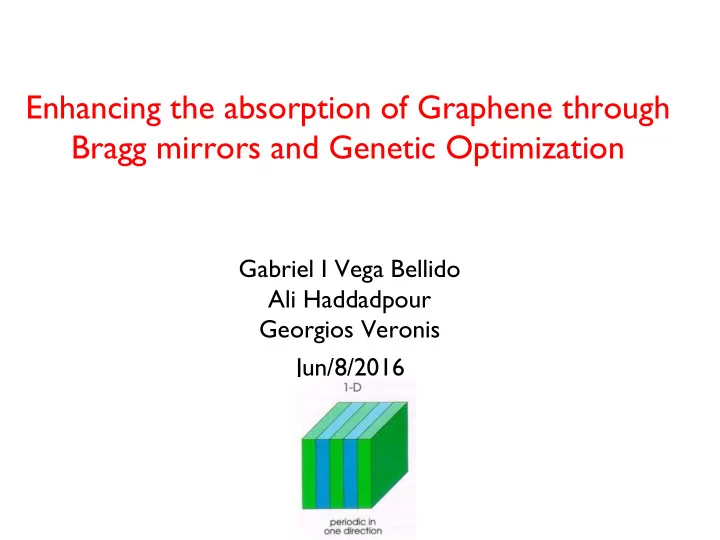

Enhancing the absorption of Graphene through Bragg mirrors and Genetic Optimization � Gabriel I Vega Bellido Ali Haddadpour Georgios Veronis Jun/8/2016
Introduction Graphene is a monolayer of carbon atoms in a two-dimensional honeycomb pattern which has been shown to possess exceptional electrical and optical properties for developing nanoelectronic and nanophotonic devices. Despite this, Graphene is a naturally weak optical absorber (~=2.6%) and as such clever concepts must be used to take full advantage of its properties. The purpose of this project was to find optimized structures so as to maximize the absorbance of graphene at several tunable wavelengths around the fiber optic wavelength of 1550nm through the use of simulations.
Model • Pairs of silicon and silica layers with varying thicknesses surrounding a one layer cavity of graphene. • Mirrors repeatedly reflect incident light towards the layer of graphene. • The thicknesses of the layers must be optimized for each set of wavelengths.
Genetic Algorithm A genetic algorithm is used to find the optimal thicknesses for each particular set of wavelengths. It is named such because it is based on the principles of natural selection and it works as follows: Initialize Evaluate Selection Crossover Population Termination Solution Set Mutation Yes Criterion
Results: Two Wavelengths (a) (b) a) 1200/1900nm b) 1300/1800nm c) 1400/1700nm d) 1500/1600nm (c) (d)
Results: Three Wavelengths (a (b ) ) a) 1200/1900nm b) 1300/1800nm c) 1400/1700nm d) 1500/1600nm (c) ( d)
Conclusion This project makes it clear that there are suitable Fabry-Perot cavity structures for optimizing the absorbance of graphene at different tunable wavelengths. Despite this it is important to note that the quality of the optimizations drops as the amount of wavelengths to be optimized increases.
References 1) J. Joannopoulos, R. Meade, and J. Winn. Photonic Crystals: Molding the Flow of Light. Princeton University Press, 1st edition, 1995. 2) Goldstein, S. (2014, October 3). Green Capitalism. Retrieved June 07, 2016 3) Furchi, M., Urich, et Al. (2012). Microcavity-Integrated Graphene Photodetector. Nano Letters Nano Lett., 12 (6), 2773-2777. doi:10.1021/nl204512x 4) Kunjer, A., & Krishnamurty, S. (n.d.). Genetic Algorithms in Mechanism Synthesis. Retrieved June 07, 2016
Recommend
More recommend